Optimization of Spatial Pattern of Land Use: Progress, Frontiers, and Prospects
Abstract
:1. Introduction
2. Data and Methods
3. Results
3.1. Trend Analysis of Literature Publication
3.2. Network Analysis of Cooperation between Countries, Institutions, and Authors
3.3. Analysis of Keywords and Stages of Development
3.4. Research Progress
3.4.1. Analysis of Spatial Measures and Drivers of Land Use
3.4.2. Ecological Effects of Spatial Changes in Land Use
3.4.3. Simulation and Prediction of Spatial Changes in Land Use
3.5. Research Frontiers
3.5.1. Measuring Spatial Changes in Land Use with Both Quantity and Quality
3.5.2. Ecological Mechanism and Mutual Feedback Effects
3.5.3. The Theoretical Framework and Model Construction of Spatial Simulation and Prediction Based on Interdisciplinary and Technological Integration
3.5.4. Adaptive Management of Sustainable Land Use under Multiple Pressures
4. Discussion and Perspectives
4.1. Concept and Theoretical Framework Innovation
4.2. Choice of Scale and Time Mechanism
4.3. Revealing the Mechanism of Causal Emergence Theory by Integrating Micro and Macro Scales
4.4. Identification of Transformation Thresholds
4.5. Improving Uncertainty in Simulation and Prediction
5. Conclusions
- (1)
- The description of the spatial pattern of land use has transformed from pattern to function and then to well-being. The driving mechanism shifts to both the “expansion effect” caused by rapid economic growth and the “restraint effect” caused by ecological and environmental constraints. To optimize the spatial pattern of land use under the ecological restoration paradigm, ecological elements, processes, and effects have become the focus of attention.
- (2)
- Revealing the socio-ecological mechanisms of spatial changes in land use and elucidating land system network flow paths and response mechanisms have become a research frontier. The research focus of spatial land use simulation forecasting includes improving the accuracy of supply and demand forecasting, matching spatial and temporal distribution, the convenience of management operation, and the sustainability of adapting to long-term development. Research on the role of different stakeholders, response characteristics and adaptation paths, and policy transmission mechanisms is also being strengthened.
- (3)
- Facing the needs for spatial optimization of land use under multi-dimensional integration of society and ecology, the multi-level transmission of scale, and multi-objective tradeoff, we propose to carry out spatial optimization of land under the framework of “element sets–network structure–system functions–human welfare”. Based on the constructed conceptual model, future research needs to strengthen the conceptual and theoretical innovations underlying the accumulation of empirical studies. Meanwhile, it should also focus on the selection of spatio-temporal mechanisms, the revelation of causal emergence mechanisms, the determination of transformation thresholds, and coping with uncertainties in simulation predictions.
Author Contributions
Funding
Institutional Review Board Statement
Informed Consent Statement
Data Availability Statement
Conflicts of Interest
References
- Sterling, S.M.; Ducharne, A.; Polcher, J. The impact of global land-cover change on the terrestrial water cycle. Nat. Clim. Chang. 2013, 3, 385–390. [Google Scholar] [CrossRef]
- Mooney, H.A.; Duraiappah, A.; Larigauderie, A. Evolution of natural and social science interactions in global change research programs. Proc. Natl. Acad. Sci. USA 2013, 110 (Suppl. S1), 3665–3672. [Google Scholar] [CrossRef] [PubMed] [Green Version]
- Ellis, E.C. Land use and ecological change: A 12,000-year history. Annu. Rev. Environ. Resour. 2021, 46, 1–33. [Google Scholar] [CrossRef]
- Fischer, J.; Riechers, M.; Loos, J.; Martin-Lopez, B.; Temperton, V.M. Making the UN decade on ecosystem restoration a social-ecological endeavour. Trends Ecol. Evol. 2021, 36, 20–28. [Google Scholar] [CrossRef]
- Jin, G.; Deng, X.; Chu, X.; Li, Z.; Wang, Y. Optimization of land-use management for ecosystem service improvement: A review. Phys. Chem. Earth. 2017, 101, 70–77. [Google Scholar] [CrossRef]
- Turner, B.; Skole, D.L.; Sanderson, S.; Fischer, G.; Fresco, L.; Leemans, R. Land-use and land-cover change: Science/research plan. Glob. Chang. Rep. 1995, 43, 669–679. [Google Scholar] [CrossRef]
- Gao, L.; Bryan, B.A. Finding pathways to national-scale land-sector sustainability. Nature 2017, 544, 217. [Google Scholar] [CrossRef]
- Liu, Y.; Wang, J. Theoretical analysis and technical methods of “multiple planning integration” in the rural to urban transition period in China. Prog. Geogr. 2016, 35, 529–536. [Google Scholar] [CrossRef] [Green Version]
- Willemen, L.; Barger, N.N.; Brink, B.T.; Cantele, M.; Erasmus, B.F.N.; Fisher, J.L.; Gardner, T.; Holland, T.G.; Kohler, F.; Kotiaho, J.S.; et al. How to halt the global decline of lands. Nat. Sustain. 2020, 3, 164–166. [Google Scholar] [CrossRef] [Green Version]
- Rounsevell, M.D.; Pedroli, B.; Erb, K.-H.; Gramberger, M.; Busck, A.G.; Haberl, H.; Kristensen, S.; Kuemmerle, T.; Lavorel, S.; Lindner, M.; et al. Challenges for land system science. Land Use Policy 2012, 29, 899–910. [Google Scholar] [CrossRef]
- Verburg, P.H.; Erb, K.H.; Mertz, O.; Espindola, G. Land System Science: Between global challenges and local realities. Curr. Opin. Environ. Sustain. 2013, 5, 433–437. [Google Scholar] [CrossRef] [PubMed] [Green Version]
- Cao, Y.; Wang, J.; Li, G. Ecological restoration for territorial space: Basic concepts and foundations. China Land Sci. 2019, 33, 1–10. [Google Scholar] [CrossRef]
- Fang, C.; Yang, J.; Fang, J.; Huang, X.; Zhou, Y. Optimization transmission theory and technical pathways that describe multiscale urban agglomeration spaces. China Geogr. Sci. 2018, 28, 543–554. [Google Scholar] [CrossRef] [Green Version]
- Li, F.; Zhou, M.; Qin, Z. Generated land systems: Recognition and prospects of land system science. Environ. Rev. 2020, 28, 199–207. [Google Scholar] [CrossRef]
- Verburg, P.H.; Crossman, N.; Ellis, E.C.; Heinimann, A.; Hostert, P.; Mertz, O.; Nagendra, H.; Sikor, T.; Erb, K.-H.; Golubiewski, N.; et al. Land system science and sustainable development of the earth system: A global land project perspective. Anthropocene 2015, 12, 29–41. [Google Scholar] [CrossRef] [Green Version]
- Long, H.; Zhang, Y.; Ma, L.; Tu, S. Land use transitions: Progress, challenges and prospects. Land 2021, 10, 903. [Google Scholar] [CrossRef]
- Liu, J.; Deng, Z. Progress of research methods of LUCC spatio-temporal process. China Sci. Bull. 2009, 54, 3251–3258. [Google Scholar] [CrossRef]
- He, C.; Zhang, J.; Liu, Z.; Huang, Q. Characteristics and progress of land use/cover change research during 1990–2018. Acta Geogr. Sin. 2021, 76, 2730–2748. [Google Scholar] [CrossRef]
- Lambin, E.F.; Meyfroidt, P. Global land use change, economic globalization, and the looming land scarcity. Proc. Natl. Acad. Sci. USA 2011, 108, 3465–3472. [Google Scholar] [CrossRef] [Green Version]
- GLP. Science Plan and Implementation Strategy; IGBP Report No. 53/IHDP Report No. 19; IGBP Secretariat: Stockholm, Sweden, 2005; Available online: https://digital.library.unt.edu/ark:/67531/metadc11885/m2/1/high_res_d/IGAC-SP.pdf (accessed on 27 April 2022).
- Uhrqvist, O.; Linnér, B.O. Narratives of the past for Future Earth: The historiography of global environmental change research. Anthr. Rev. 2015, 2, 159–173. [Google Scholar] [CrossRef]
- Sha, Z.; Bai, Y.; Li, R.; Lan, H.; Zhang, X.; Li, J.; Liu, X.; Chang, S.; Xie, Y. The global carbon sink potential of terrestrial vegetation can be increased substantially by optimal land management. Commun. Earth Environ. 2022, 3, 8. [Google Scholar] [CrossRef]
- Kuang, W. Issues regarding on spatial pattern change of national land space and its overall implementation on beautiful vision in new era. Resour. Sci. 2019, 41, 23–32. [Google Scholar] [CrossRef] [Green Version]
- Wang, Q.; Wang, W.; Jin, W. New perspectives and new methods on the research of intensive urban land use in China: Literature review and prospect. China Popul. Resour. Environ. 2017, 27 (Suppl. S1), 95–100. [Google Scholar]
- Li, X.; Yang, L.; Tian, W.; Xu, X.; He, C. Land use and land cover change in agro-pastoral ecotone in Northern China: A review. China J. Appl. Ecol. 2018, 29, 3487–3495. [Google Scholar] [CrossRef]
- Kuchma, T.; Tarariko, O.; Syrotenko, O. Landscape diversity indexes application for agricultural land use optimization. Procedia Technol. 2013, 8, 566–569. [Google Scholar] [CrossRef] [Green Version]
- Liang, X.; Jin, X.; Ren, J.; Gu, Z.; Zhou, Y. A research framework of land use transition in suzhou city coupled with land use structure and landscape multifunctionality. Sci. Total Environ. 2020, 737, 139932. [Google Scholar] [CrossRef]
- Huang, A.; Xu, Y.; Lu, L.; Liu, C.; Zhang, Y.; Hao, J.; Wang, H. Research progress of the identification and optimization of production-living-ecological spaces. Prog. Geogr. 2020, 39, 503–518. [Google Scholar] [CrossRef]
- Chen, B.; Zhang, F. Theory and methodology for sustainable land use indicator system in China. J. Nat. Resour. 2001, 16, 197–203. [Google Scholar] [CrossRef]
- Ustaoglu, E.; Aydnoglu, A.C. Suitability evaluation of urban construction land in pendik district of Istanbul, Turkey. Land Use Policy 2020, 99, 104783. [Google Scholar] [CrossRef]
- Zou, L.; Liu, Y.; Yang, J.; Yang, S.; Wang, Y.; Hu, X. Quantitative identification and spatial analysis of land use ecological-production-living functions in rural areas on China’s southeast coast. Habitat Int. 2020, 100, 102182. [Google Scholar] [CrossRef]
- Meng, J.; Jiang, S.; Laba, Z.; Zhang, W. The spatial and temporal analysis of land use conflict in the middle reaches of the Heihe River based on landscape pattern. Sci. Geogr. Sin. 2020, 40, 1553–1562. [Google Scholar] [CrossRef]
- Long, H.; Chen, K. Urban-rural integrated development and land use transitions: A perspective of land system science. Acta Geogr. Sin. 2021, 76, 295–309. [Google Scholar] [CrossRef]
- Peng, J.; Li, H.; Liu, Y.; Hu, Y.; Yang, Y. Identification and optimization of ecological security pattern in Xiong’an New Area. Acta Geogr. Sin. 2018, 73, 701–710. [Google Scholar] [CrossRef]
- Yang, Z.; Zhu, X.; Moodie, D.R. Optimization of land use in a new urban district. J. Urban Plan Dev. 2015, 141, 05014010. [Google Scholar] [CrossRef]
- Luo, X.; Lu, X.; Jin, G.; Wan, Q.; Zhou, M. Optimization of urban land-use structure in China’s rapidly developing regions with eco-environmental constraints. Phys. Chem Earth Parts A/B/C 2019, 110, 8–13. [Google Scholar] [CrossRef]
- Phalan, B.T. What have we learned from the land sparing-sharing model? Sustainability 2018, 10, 1760. [Google Scholar] [CrossRef] [Green Version]
- Stehfest, E.; van Zeist, W.-J.; Valin, H.; Havlik, P.; Popp, A.; Kyle, P.; Tabeau, A.; Mason-D’Croz, D.; Hasegawa, T.; Bodirsky, B.L.; et al. Key determinants of global land-use projections. Nat. Commun. 2019, 10, 2166. [Google Scholar] [CrossRef] [Green Version]
- Sans, G.H.C.; Aguiar, S.; Vallejos, M.; Parueloab, J.M. Assessing the effectiveness of a land zoning policy in the Dry Chaco. The Case of Santiago del Estero, Argentina. Land Use Policy 2018, 70, 313–321. [Google Scholar] [CrossRef]
- Beringer, T.I.M.; Lucht, W.; Schaphoff, S. Bioenergy production potential of global biomass plantations under environmental and agricultural constraints. GCB Bioenergy 2011, 3, 299–312. [Google Scholar] [CrossRef]
- Foley, J.A.; DeFries, R.; Asner, G.P.; Barford, C.; Bonan, G.; Carpenter, S.R.; Chapin, F.S.; Coe, M.T.; Daily, G.C.; Gibbs, H.K.; et al. Global consequences of land use. Science 2005, 309, 570–574. [Google Scholar] [CrossRef] [Green Version]
- Rotem-Mindali, O.; Michael, Y.; Helman, D.; Lensky, I.M. The role of local land-use on the urban heat island effect of Tel Aviv as assessed from satellite remote sensing. Appl. Geogr. 2015, 56, 145–153. [Google Scholar] [CrossRef]
- Setti, S.; Maheswaran, R.; Radha, D.; Sridhar, V.; Barik, K.K.; Narasimham, M.L. Attribution of hydrologic changes in a tropical river basin to rainfall variability and land-use change: Case study from India. J. Hydrol Eng. 2020, 25, 05020015. [Google Scholar] [CrossRef]
- Olorunfemi, I.E.; Fasinmirin, J.T. Land use management effects on soil hydrophobicity and hydraulic properties in Ekiti State, forest vegetative zone of Nigeria. Catena 2017, 155, 170–182. [Google Scholar] [CrossRef]
- Skole, D.; Tucker, C. Tropical deforestation and habitat fragmentation in the Amazon: Satellite data from 1978 to 198. Science 1993, 260, 1905–1910. [Google Scholar] [CrossRef] [PubMed] [Green Version]
- Millennium Assessment. Millennium Ecosystem Assessment Synthesis Report; Island Press: Washington, DC, USA, 2005; Available online: http://www.millenniumassessment.org/en/index.html (accessed on 27 April 2022).
- Li, R.; Li, Y.; Hu, H. Support of ecosystem services for spatial planning theories and practices. Acta Geogr. Sin. 2020, 75, 2417–2430. [Google Scholar] [CrossRef]
- Bendor, T.K.; Spurlock, D.; Woodruff, S.C.; Olander, L. A research agenda for ecosystem services in American environmental and land use planning. Cities 2017, 60, 260–271. [Google Scholar] [CrossRef]
- Li, S.; Wang, Y.; Zhu, W.; Zhang, J.; Liu, Y.; Gao, Y.; Wang, Y.; Li, Y. Research framework of ecosystem services geography from spatial and regional perspectives. Acta Geogr. Sin. 2014, 69, 1628–1639. [Google Scholar] [CrossRef]
- Zhang, W.; Huang, B. Soil erosion evaluation in a rapidly urbanizing city (Shenzhen, China) and implementation of spatial land-use optimization. Environ. Sci. Pollut. Res. 2015, 22, 4475–4490. [Google Scholar] [CrossRef]
- Hu, Y.; Chen, S. Optimizing the ecological networks based on the supply and demand of ecosystem services in Xiamen-Zhangzhou-Quanzhou region. J. Nat. Resour. 2021, 36, 342–355. [Google Scholar] [CrossRef]
- Long, H.L. Land use policy in China: Introduction. Land Use Policy 2014, 40, 1–5. [Google Scholar] [CrossRef]
- Qiu, B.; Lu, S.; Zhou, M.; Zhang, L.; Yu, D. A hybrid inexact optimization method for land-use allocation in association with environmental/ecological requirements at a watershed level. Sustainability 2015, 7, 4643–4667. [Google Scholar] [CrossRef] [Green Version]
- Liu, J.; Zhang, Z.; Zhang, S.; Yan, C.; Wu, S.; Li, R.; Kunag, W.; Shi, W.; Huang, L.; Ning, J.; et al. Innovation and development of remote sensing-based land use change studies based on Shupeng Chen’s academic thoughts. J. Geo-Inf. Sci. 2020, 22, 680–687. [Google Scholar] [CrossRef]
- Gao, P.; Wang, H.; Cushman, S.A.; Cheng, C.; Ye, S. Sustainable land-use optimization using NSGA-II: Theoretical and experimental comparisons of improved algorithms. Landsc. Ecol. 2021, 36, 1877–1892. [Google Scholar] [CrossRef]
- Zhang, Z.; Zhou, M.; Ou, G.; Tan, S.; Nie, X. Land suitability evaluation and an interval stochastic fuzzy programming-based optimization model for land-use planning and environmental policy analysis. Int. J. Environ. Res. Public Health 2019, 16, 4124. [Google Scholar] [CrossRef] [Green Version]
- Dai, E.; Ma, L. Review on land change modeling approaches. Prog. Geogr. 2018, 37, 152–162. [Google Scholar] [CrossRef] [Green Version]
- Nikkami, D.; Shabani, M.; Ahmadi, H. Land use scenarios and optimization in a watershed. J. Appl. Sci. 2009, 9, 287–295. [Google Scholar] [CrossRef]
- Kuzmanovski, V.; Larsen, D.E.; Henriksen, C.B. Optimization of arable land use towards meat-free and climate-smart agriculture: A case study in food self-sufficiency of Vietnam. In Proceedings of the 2019 IEEE International Conference on Big Data, Los Angeles, CA, USA, 9–12 December 2019; IEEE: Manhattan, NY, USA, 2019; pp. 5140–5148. [Google Scholar] [CrossRef]
- Li, F.; Yuan, G.; Cai, L.; Sun, C.; Jiang, P. Sustainable land-use allocation: A multiobjective particle swarm optimization model and application in changzhou, china. J. Urban Plan. Dev. 2018, 144, 04018010. [Google Scholar] [CrossRef]
- Yuan, M.; Liu, Y.L.; He, J.H.; Liu, D.F. Regional land-use allocation using a coupled MAS and GA model: From local simulation to global optimization, a case study in Caidian District, Wuhan, China. Cartogr. Geogr. Inf. Sci. 2014, 41, 363–378. [Google Scholar] [CrossRef]
- Liu, X.; Ou, J.; Li, X.; Ai, B. Combining system dynamics and hybrid particle swarm optimization for land use allocation. Ecol. Model 2013, 257, 11–24. [Google Scholar] [CrossRef]
- Liu, X.; Liang, X.; Li, X.; Xu, X.; Ou, J.; Chen, Y.; Li, S.; Wang, S.; Pei, F. A future land use simulation model (flus) for simulating multiple land use scenarios by coupling human and natural effects. Landsc. Urban Plan. 2017, 168, 94–116. [Google Scholar] [CrossRef]
- Strauch, M.; Cord, A.F.; Paetzold, C.; Lautenbach, S.; Kaim, A.; Schweitzer, C.; Seppelt, R.; Volk, M. Constraints in multi-objective optimization of land use allocation-repair or penalize? Environ. Model. Softw. 2019, 118, 241–251. [Google Scholar] [CrossRef]
- Türk, E.; Zwick, P.D. Optimization of land use decisions using binary integer programming: The case of Hillsborough County, Florida, USA. J. Environ. Manag. 2019, 235, 240–249. [Google Scholar] [CrossRef]
- Zhu, W.; Gao, Y.; Zhang, H.; Liu, L. Optimization of the land use pattern in Horqin Sandy Land by using the CLUMondo model and Bayesian belief network. Sci. Total Environ. 2020, 739, 139929. [Google Scholar] [CrossRef] [PubMed]
- Wu, Y.; Zhang, X.; Li, C.; Hao, F.; Yin, G. Improvement of ecosystem service function in watershed by ecological restoration measures: A case study in Chaohe River Basin. Acta Ecol. Sin. 2020, 40, 5168–5178. [Google Scholar] [CrossRef]
- Chen, L.; Liu, Y.; Lv, Y.; Feng, X.; Fu, B. Landscape pattern analysis in landscape ecology: Current, challenges and future. Acta Ecol. Sin. 2008, 28, 5521–5531. [Google Scholar] [CrossRef]
- Huang, J.; Lin, H.; Qi, X. A literature review on optimization of spatial development pattern based on ecological-production-living space. Prog. Geogr. 2017, 36, 378–391. [Google Scholar] [CrossRef] [Green Version]
- Gao, J.; O’Neill, B.C. Mapping global urban land for the 21st century with data-driven simulations and Shared Socioeconomic Pathways. Nat. Commun. 2020, 11, 2302. [Google Scholar] [CrossRef]
- Tu, X.; Chen, Z.; Wang, B.; Xu, C. Mining regional patterns of land use with adaptive adjacent criteria. Cartogr. Geogr. Inf. Sci. 2020, 47, 418–431. [Google Scholar] [CrossRef]
- Ellis, E.C.; Ramankutty, N. Putting people in the map: Anthropogenic biomes of the world. Front. Ecol. Environ. 2008, 6, 439–447. [Google Scholar] [CrossRef] [Green Version]
- Verburg, P.H.; Eickhout, B.; Meijl, H.V. A multi-scale, multi-model approach for analyzing the future dynamics of European land use. Ann. Reg. Sci. 2008, 42, 57–77. [Google Scholar] [CrossRef] [Green Version]
- Edith, B.; Xue, B. A review of influences of land use and land cover change on ecosystems. Chin. J. Plant Ecol. 2020, 44, 543–552. [Google Scholar] [CrossRef]
- Fu, B.; Zhang, L. Land-use change and ecosystem services: Concepts, methods and progress. Prog. Geogr. 2014, 33, 441–446. [Google Scholar] [CrossRef]
- Bala, G.; Cal De Ira, K.; Wickett, M.; Phillips, T.J.; Mirin, A. Combined climate and carbon-cycle effects of large-scale deforestation. Proc. Natl. Acad. Sci. USA 2007, 104, 6550–6555. [Google Scholar] [CrossRef] [Green Version]
- Pan, P.; Yang, G.; Su, W. Progress on effects of land use change on land productivity. Prog. Geogr. 2012, 31, 539–550. [Google Scholar] [CrossRef]
- Wang, X.; Meng, J. Research progress on the environmental-ecological impacts of land use change. Acta Sci. Nat. Univ. Pekin. 2014, 50, 1133–1140. [Google Scholar] [CrossRef]
- Chen, D.; Li, J.; Yang, X.; Zhou, Z.; Pan, Y.; Li, M. Quantifying water provision service supply, demand and spatial flow for land use optimization: A case study in the YanHe watershed. Ecosyst. Serv. 2020, 43, 101117. [Google Scholar] [CrossRef]
- Felipe-Lucia, M.R.; Soliveres, S.; Penone, C.; Fischer, M.; Allan, E. Land-use intensity alters networks between biodiversity, ecosystem functions, and services. Proc. Natl. Acad. Sci. USA 2020, 117, 28140–28149. [Google Scholar] [CrossRef]
- Zhang, Q.; Li, F.; Wang, D.; Li, M.; Chen, D. Analysis on changes of ecological spatial connectivity in Jiangsu Province based on ecological network. Acta Ecol. Sin. 2021, 41, 3007–3020. [Google Scholar] [CrossRef]
- Liu, Y.; Wei, T.; He, J.; Liu, Y.; Ai, T.; Liu, D. A land-use spatial optimization model based on genetic optimization and game theory. Comput. Environ. Urban Syst. 2015, 49, 1–14. [Google Scholar] [CrossRef]
- Nie, Y.; Avraamidou, S.; Xiao, X.; Pistikopoulos, E.N.; Li, J.; Zeng, Y.; Song, F.; Yu, J.; Zhu, M. A food-energy-water nexus approach for land use optimization. Sci. Total Environ. 2019, 659, 7–19. [Google Scholar] [CrossRef] [Green Version]
- García, G.A.; Rosas, E.P.; García-Ferrer, A.; Barrios, P.M. Multi-Objective spatial optimization: Sustainable land use allocation at sub-regional scale. Sustainability 2017, 9, 927. [Google Scholar] [CrossRef] [Green Version]
- Yang, L.; Zhu, A.; Shao, J.; Chi, T. A knowledge-informed and pareto-based artificial bee colony optimization algorithm for multi-objective land-use allocation. ISPRS Int. J. Geo-Inf. 2018, 7, 63. [Google Scholar] [CrossRef] [Green Version]
- Pan, Z.; Liu, P.; Gao, S.; Xia, J.; Chen, J.; Cheng, L. Improving hydrological projection performance under contrasting climatic conditions using spatial coherence through a hierarchical Bayesian regression framework. Hydrol. Earth Syst. Sci. 2019, 23, 3405–3421. [Google Scholar] [CrossRef] [Green Version]
- Liu, J.; Shao, Q.; Yan, X. An overview of the progress and research framework on the effects of land use change upon global climate. Adv. Earth Sci. 2011, 26, 1015–1022. [Google Scholar] [CrossRef]
- Coruhlu, Y.E.; Solgun, N.; Baser, V.; Terzi, F. Revealing the solar energy potential by integration of GIS and AHP in order to compare decisions of the land use on the environmental plans. Land Use Policy 2022, 113, 105899. [Google Scholar] [CrossRef]
- Cobuloglu, H.I.; Büyüktahtakın, İ.E. Food vs. biofuel: An optimization approach to the spatio-temporal analysis of land-use competition and environmental impacts. Appl. Energy 2015, 140, 418–434. [Google Scholar] [CrossRef]
- Cotter, M.; Berkhoff, K.; Gibreel, T.; Ghorbani, A.; Golbon, R.; Nuppenau, E.A.; Sauerborn, J. Designing a sustainable land use scenario based on a combination of ecological assessments and economic optimization. Ecol. Indic. 2014, 36, 779–787. [Google Scholar] [CrossRef]
- Domptail, S.; Nuppenau, E.A. The role of uncertainty and expectations in modeling (range) land use strategies: An application of dynamic optimization modeling with recursion. Ecol. Econ. 2010, 69, 2475–2485. [Google Scholar] [CrossRef]
- Li, S.; Xiao, W.; Zhao, Y.; Lv, X. Incorporating ecological risk index in the multi-process MCRE model to optimize the ecological security pattern in a semi-arid area with intensive coal mining: A case study in northern China. J. Clean. Prod. 2020, 247, 119143. [Google Scholar] [CrossRef]
- Bagstad, K.J.; Johnson, G.W.; Voigt, B.; Villac, F. Spatial dynamics of ecosystem service flows: A comprehensive approach to quantifying actual services. Ecosyst. Serv. 2013, 4, 117–125. [Google Scholar] [CrossRef]
- Peng, J.; Li, B.; Dong, J.; Liu, Y.; Lyu, D.; Du, Y.; Luo, M.; Wu, J. Basic logic of territorial ecological restoration. China Land Sci. 2020, 34, 18–26. [Google Scholar] [CrossRef]
- Rockström, J.; Steffen, W.; Noone, K.; Persson, Å.; Chapin, F.S., III; Lambin, E.F.; Lenton, T.M.; Scheffer, M.; Folke, C.; Schellnhuber, H.J.; et al. A safe operating space for humanity. Nature 2009, 461, 472–475. [Google Scholar] [CrossRef] [PubMed]
- Guo, R.; Luo, P.; Luo, T. Three-dimensional thinking for land management and land space resources recognition. Geogr. Res. 2018, 37, 649–658. [Google Scholar] [CrossRef]
- Zhang, Z.; Zhao, Q. Eight dimensional space ideology in land use. Hum. Geogr. 2018, 33, 9–17. [Google Scholar] [CrossRef]
- Xu, J.; Zhang, Z. Research on land sustainability evaluation indices in China for SDGs. Geogr. Geo-Inf. Sci. 2020, 36, 77–84. [Google Scholar] [CrossRef]
- Meyfroidt, P.; de Bremond, A.; Ryan, C.M.; Archer, E.; Aspinall, R.; Chhabra, A.; Camara, G.; Corbera, E.; DeFries, R.; Díaz, S.; et al. Ten facts about land systems for sus-tainability. Proc. Natl. Acad. Sci. USA 2022, 119, e2109217118. [Google Scholar] [CrossRef] [PubMed]
- Klabunde, A.; Willekens, F. Decision-making in agent-based models of migration: State of the art and challenges. Eur. J. Popul. 2016, 32, 73–97. [Google Scholar] [CrossRef] [Green Version]
- Ju, R.; Zuo, L.; Zhang, Z.; Zhao, X.; Wang, X.; Wen, Q.; Liu, F.; Xu, J.; Liu, B.; Yi, L. Methods research on describing the spatial pattern of land use types in China. Acta Geogr. Sin. 2020, 75, 143–159. [Google Scholar] [CrossRef]
- Chen, R.; Cai, Y. Scale problem and solutions in land change science. Geogr. Res. 2019, 29, 1244–1256. [Google Scholar]
- Ma, E.; Cai, J.; Lin, J.; Han, Y.; Liao, L.; Han, W. Explanation of land use/cover change from the perspective of tele-coupling. Acta Geogr. Sin. 2019, 74, 421–431. [Google Scholar] [CrossRef]
- Cui, X.; Fang, C.; Li, J.; Liu, H.; Zhang, Q. Progress in dynamic simulation modeling of urbanization and ecological environment coupling. Prog. Geogr. 2019, 38, 111–125. [Google Scholar] [CrossRef] [Green Version]
- Yao, J.; Zhang, X.; Murray, A.T. Spatial optimization for land-use allocation: Accounting for sustainability concerns. Int. Reg. Sci. Rev. 2018, 41, 579–600. [Google Scholar] [CrossRef]
- Ligmann-Zielinska, A.; Church, R.L.; Jankowski, P. Spatial optimization as a generative technique for sustainable multiobjective land-use allocation. Int. J. Geogr. Inf. Sci. 2008, 22, 601–622. [Google Scholar] [CrossRef]
- Brown, C.; Alexander, P.; Arneth, A.; Holman, I.; Rounsevell, M. Achievement of paris climate goals unlikely due to time lags in the land system. Nat. Clim. Chang. 2019, 9, 203–208. [Google Scholar] [CrossRef] [Green Version]
- Cao, K.; Zhang, W.; Wang, T. Spatio-temporal land use multi-objective optimization: A case study in Central China. Trans. GIS 2019, 23, 726–744. [Google Scholar] [CrossRef]
- Marina, F.K.; Jan, R. Conceptualizing, observing, and influencing social-ecological transitions. Ecol. Soc. 2009, 14, 292. [Google Scholar] [CrossRef]
- Sahraoui, Y.; Leski, C.; Benot, M.L.; Revers, F.; Carassou, L. Integrating ecological networks modelling in a participatory approach for assessing impacts of planning scenarios on landscape connectivity. Landsc. Urban Plan. 2021, 209, 104039. [Google Scholar] [CrossRef]
- Hoel, E.P.; Albantakis, L.; Tononi, G. Quantifying causal emergence shows that macro can beat micro. Proc. Natl. Acad. Sci. USA 2013, 110, 19790–19795. [Google Scholar] [CrossRef] [Green Version]
- Chapin, F.S., III; Carpenter, S.R.; Kofinas, G.P.; Folke, C.; Abel, N.; Clark, W.C.; Olsson, P.; Smith, D.M.S.; Walker, B.; Young, O.R.; et al. Ecosystem stewardship: Sustainability strategies for a rapidly changing planet. Trends Ecol. Evol. 2010, 25, 241–249. [Google Scholar] [CrossRef] [Green Version]
- Seppelt, R.; Lautenbach, S.; Volk, M. Identifying trade-offs between ecosystem services, land use, and biodiversity: A plea for combining scenario analysis and optimization on different spatial scales. Curr. Opin. Environ. Sustain. 2013, 5, 458–463. [Google Scholar] [CrossRef]
- Liu, J.; Kuang, W.; Zhang, Z.; Xu, X.; Qin, Y.; Ning, J.; Zhou, W.; Zhang, S.; Li, R.; Wu, C.; et al. Spatiotemporal characteristics, patterns and causes of land use changes in China since the late 1980s. Acta Geogr. Sin. 2014, 69, 3–14. [Google Scholar] [CrossRef]
- Fujino, J.; Nair, R.; Kainuma, M.; Masui, T.; Matsuoka, Y. Multi-gas mitigation analysis on stabilization scenarios using AIM global model. Energy J. 2006, 27 (Suppl. S3), 343–354. [Google Scholar] [CrossRef]
- Wang, J.; Bai, W.; Tian, G. A review on ecological risk assessment of land use. J. Nat. Resour. 2020, 35, 576–585. [Google Scholar] [CrossRef]
- Fu, B. Several key points in territorial ecological restoration. Bull. China Acad. Sci. 2021, 6, 64–69. [Google Scholar] [CrossRef]
- Ma, S.F.; Cai, Y.M.; Nian, P.H.; Zhuang, L. Models of land use planning: A review. China Land Sci. 2014, 28, 34–38&51. [Google Scholar] [CrossRef]
- Gounaridis, D.; Chorianopoulos, I.; Symeonakis, E. A random forest-cellular automata modelling approach to explore future land use/cover change in attica (greece), under different socio-economic realities and scales. Cell Host Microbe 2017, 21, 769–776. [Google Scholar] [CrossRef]
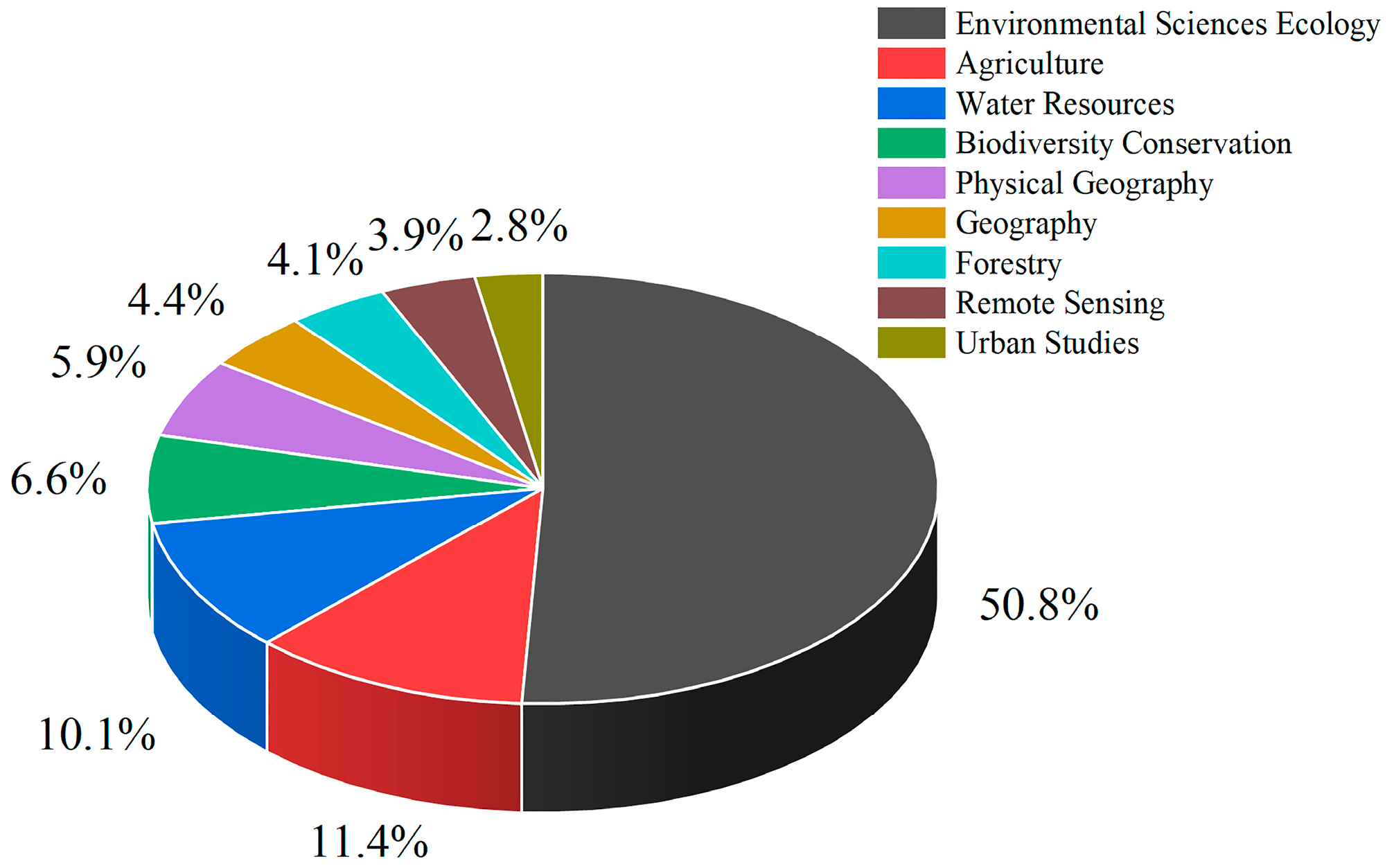
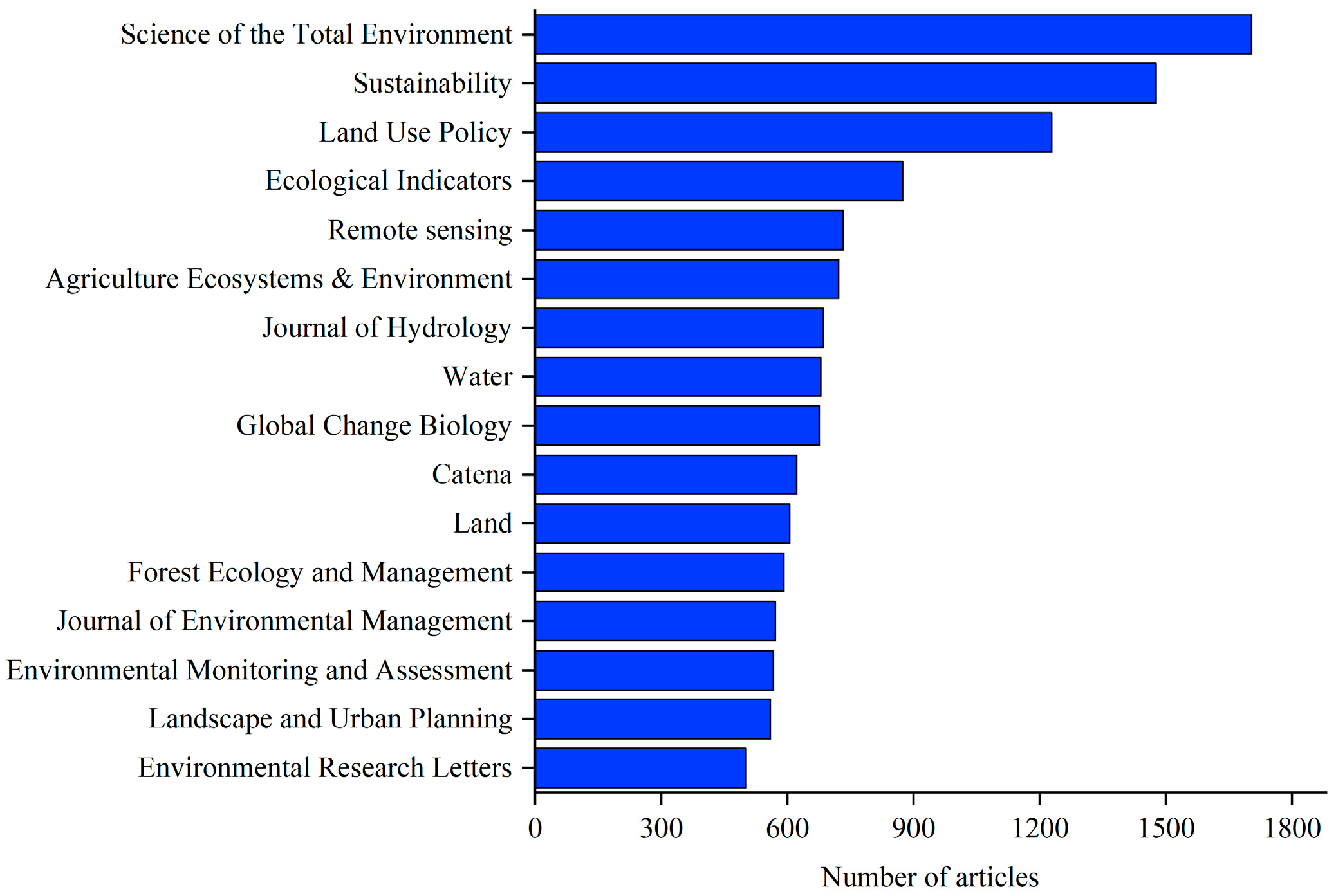
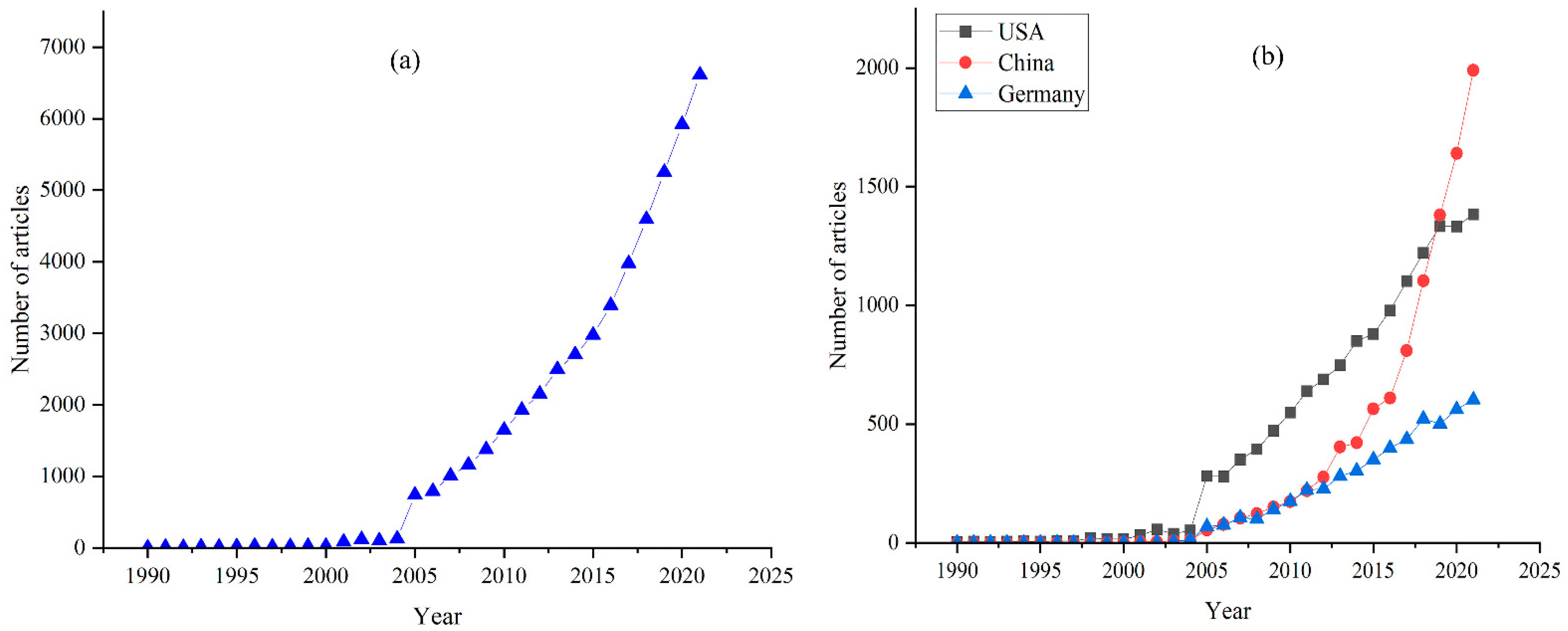
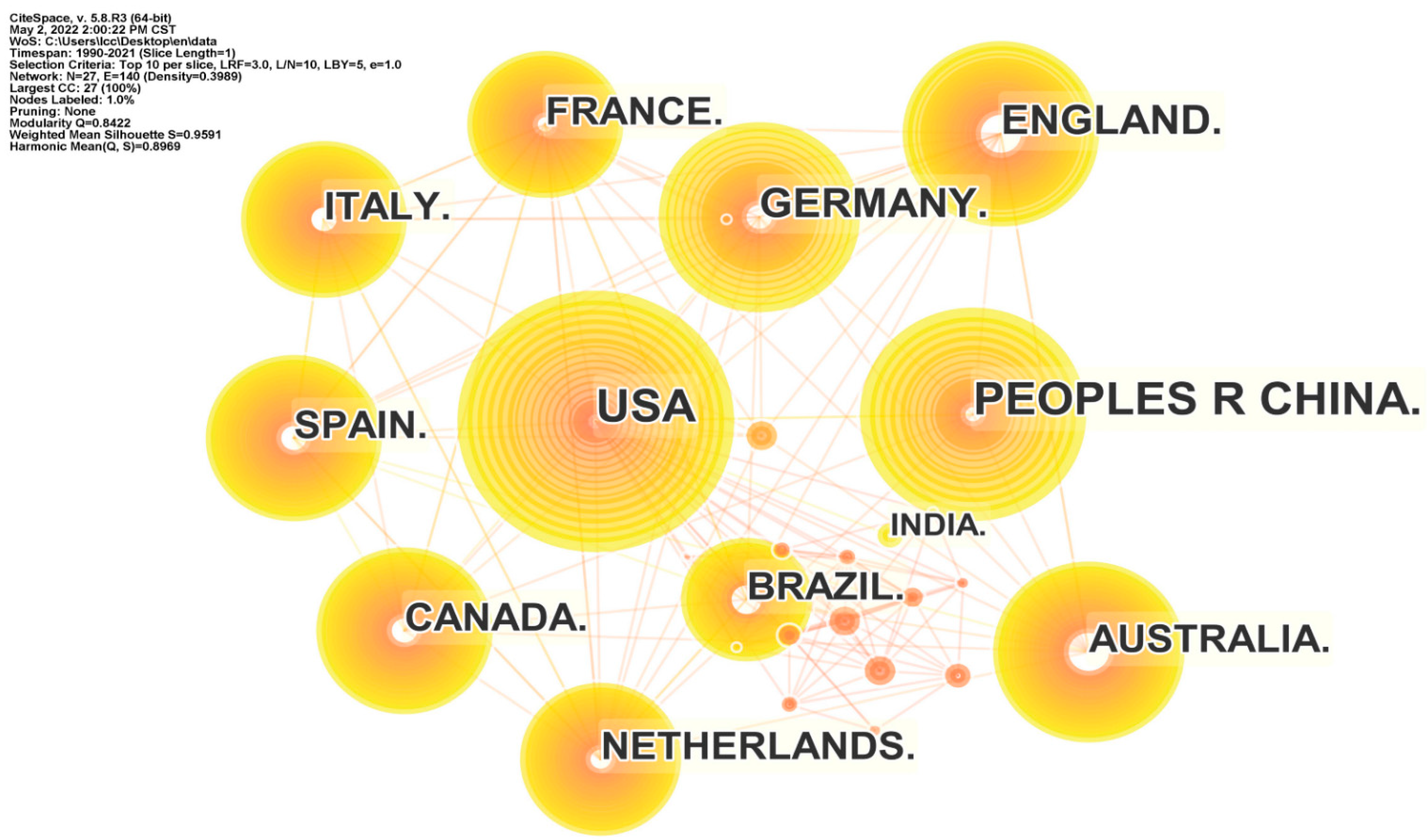

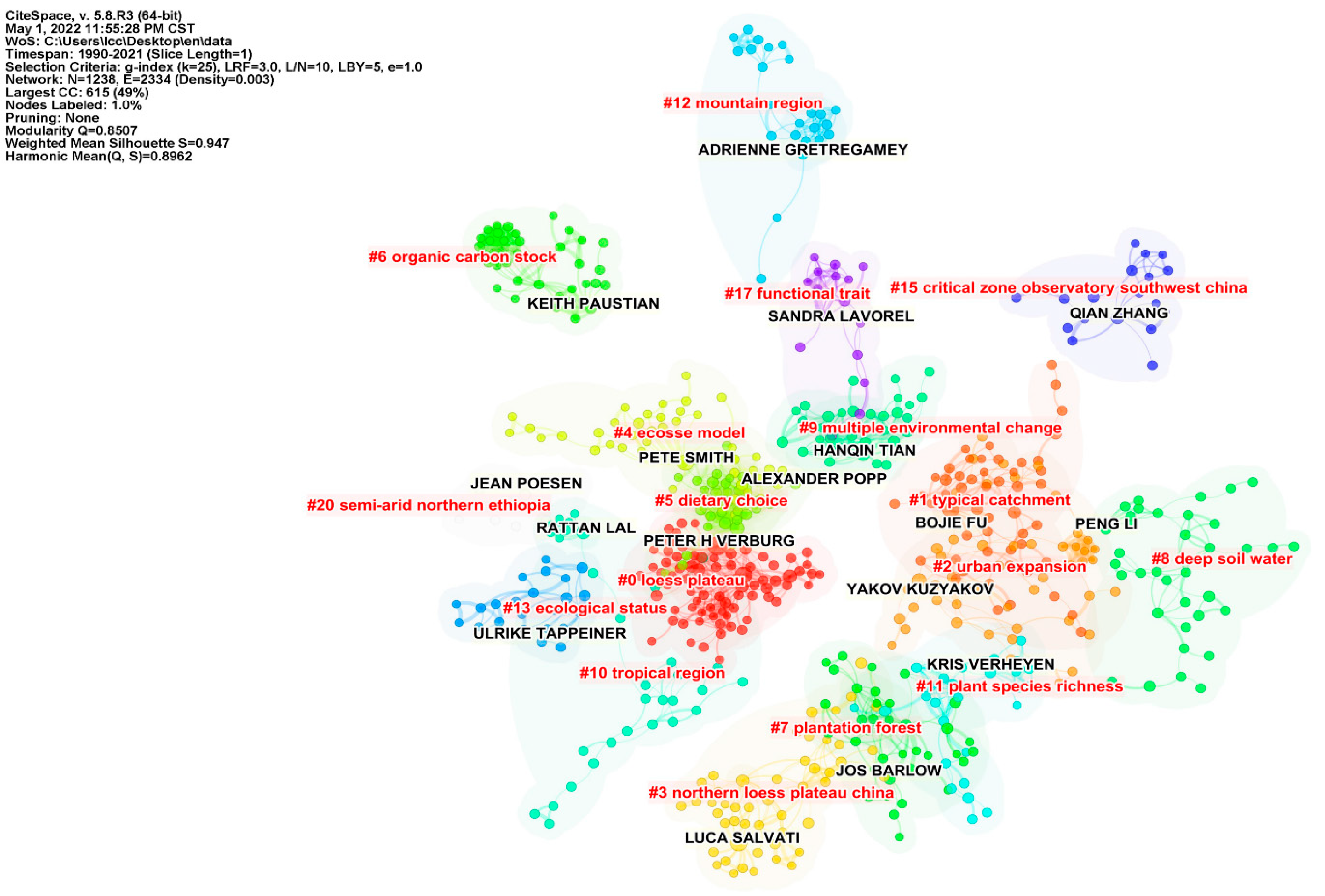
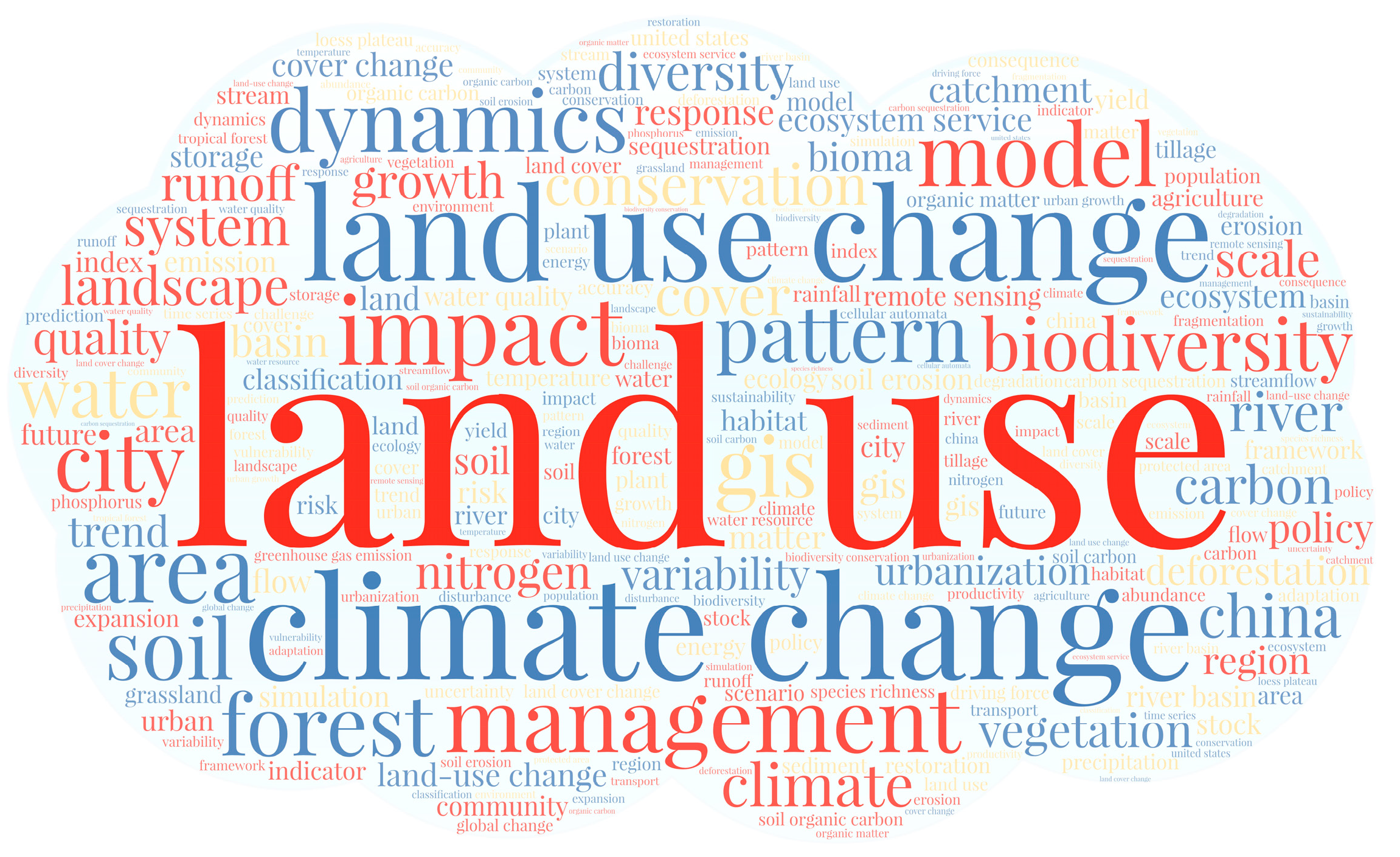
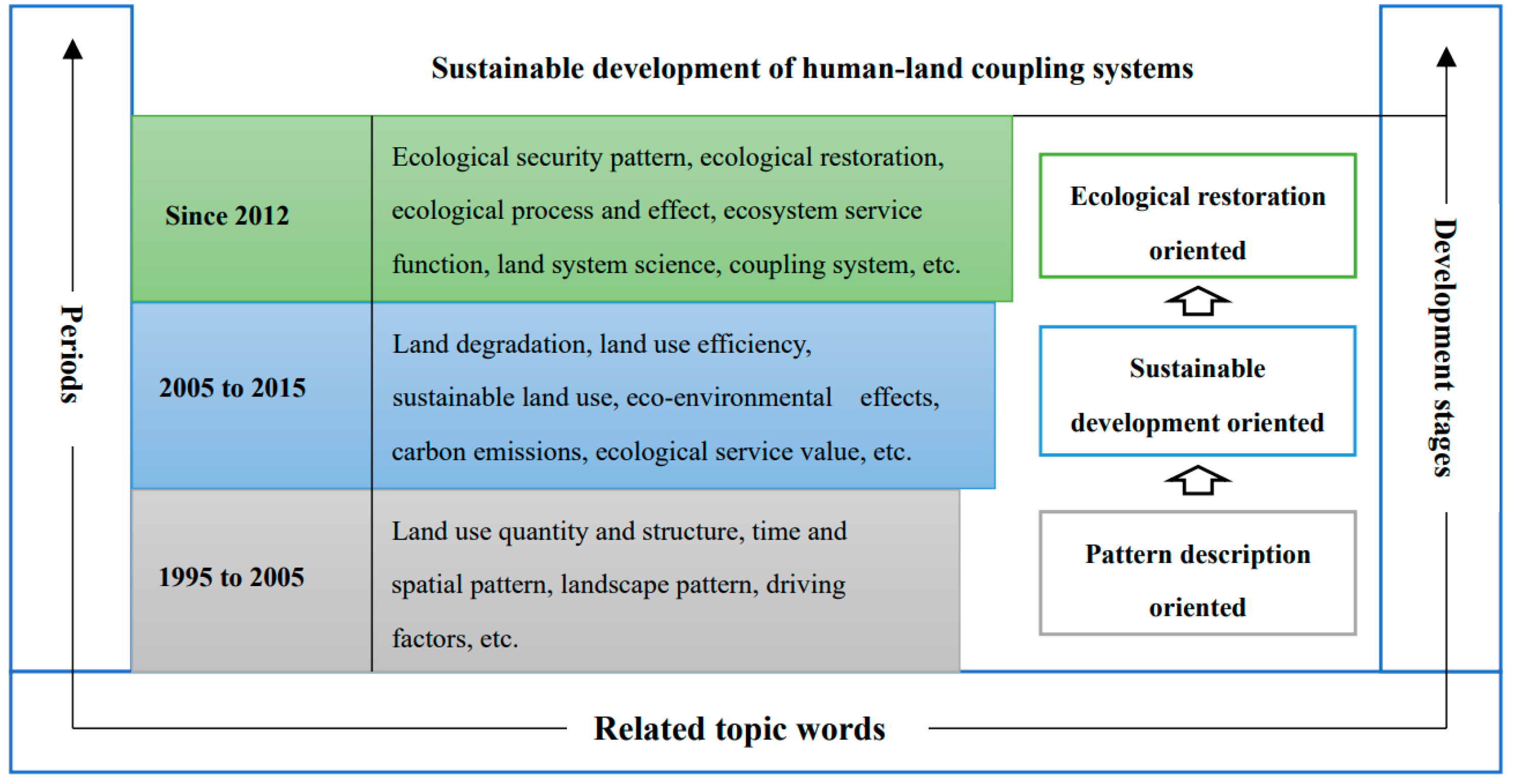
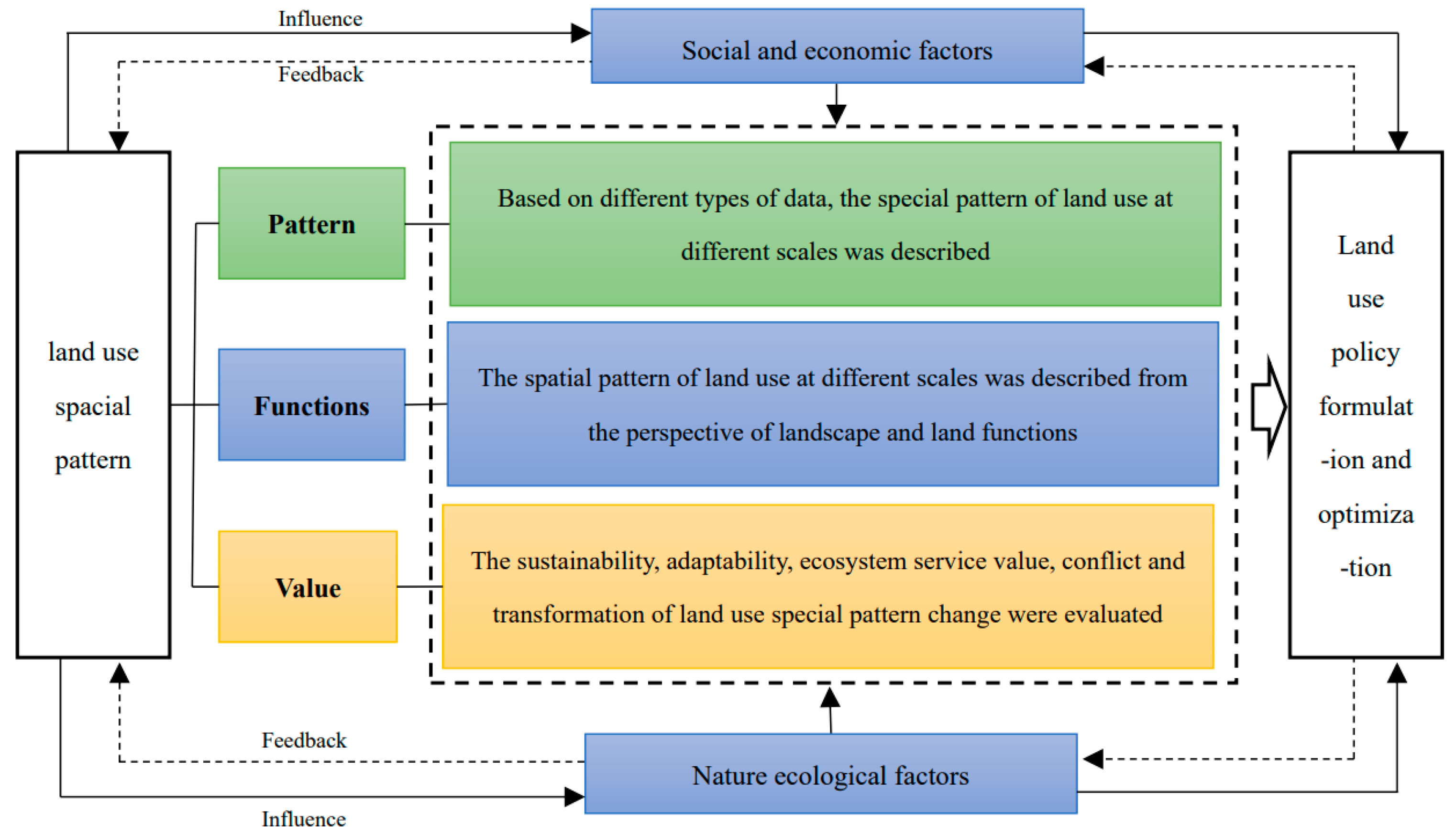
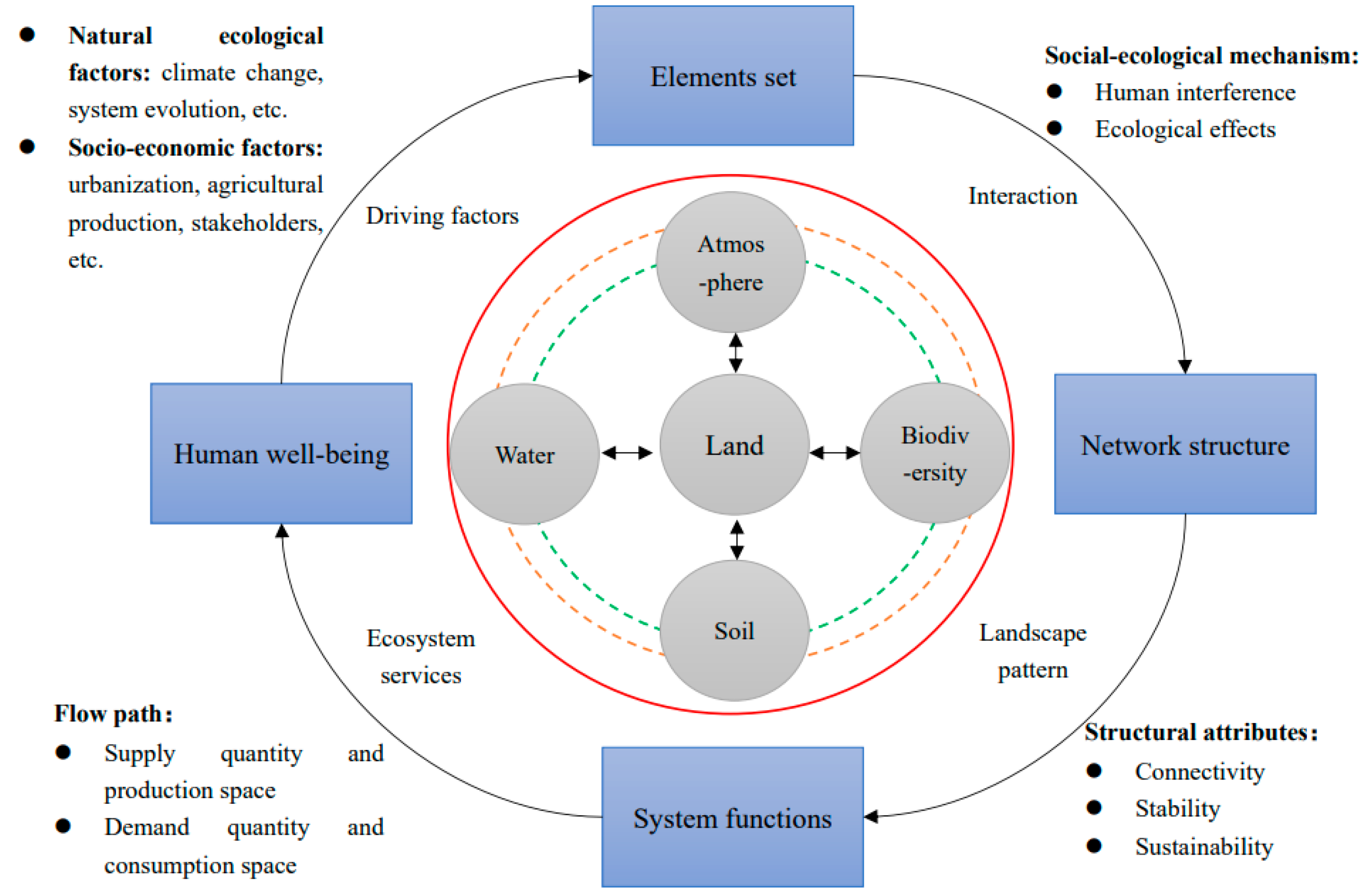
| Types | Representative Models | Main Advantages | Limitations |
|---|---|---|---|
| Spatial models | CLUE-S model, Markov model | The analysis integrates natural and socio-economic factors, spatial and non-spatial, based on the competing land use relationships. | Lack of quantification of processes and effects; failure to consider the matching of various types of economic and social data with land use space. |
| Planning models | System dynamics model, the linear programing model, multi-objective programing model | It quantifies the social and economic driving factors and the quantitative relationship of their interactions in the complex land use system and determines the supply and demand of regional land use. | Insufficient consideration of the natural properties of land and spatial representation of the results; assumption of a definite causal relationship between land use and drivers. |
| Simulation and prediction models | Cellular automaton model, FLUS model, genetic algorithm, ant colony algorithm, and particle swarm optimization and simulated annealing algorithm | It can well combine the remote-sensing image data to carry out the spatial description of the micro-mechanism; better definition of the conversion rules of land use space. | Sensitive to the input data; the use of artificial rules instead of human decision making is likely to cause a significant difference between the regularity of the spatial organization structure of the simulation system and the reality, and there is a risk of overfitting. |
| Intelligent models | Agent-based model, multi-agent models | The decisions and interactions of micro-individuals with dynamism and adaptability are considered in the simulation prediction process. | Too much emphasis on the field of sociology, insufficient attention to the complexity of human society, and easy to ignore the natural-society comprehensive adaptability problem in the process of land change. |
| Mixed/coupling models | CA–Markov model, the logistic–CA coupling of Markov model | Can give full play to the advantages of each model. | Verifying the accuracy of the results is more complex. |
Publisher’s Note: MDPI stays neutral with regard to jurisdictional claims in published maps and institutional affiliations. |
© 2022 by the authors. Licensee MDPI, Basel, Switzerland. This article is an open access article distributed under the terms and conditions of the Creative Commons Attribution (CC BY) license (https://creativecommons.org/licenses/by/4.0/).
Share and Cite
Liu, C.; Deng, C.; Li, Z.; Liu, Y.; Wang, S. Optimization of Spatial Pattern of Land Use: Progress, Frontiers, and Prospects. Int. J. Environ. Res. Public Health 2022, 19, 5805. https://doi.org/10.3390/ijerph19105805
Liu C, Deng C, Li Z, Liu Y, Wang S. Optimization of Spatial Pattern of Land Use: Progress, Frontiers, and Prospects. International Journal of Environmental Research and Public Health. 2022; 19(10):5805. https://doi.org/10.3390/ijerph19105805
Chicago/Turabian StyleLiu, Changchang, Chuxiong Deng, Zhongwu Li, Yaojun Liu, and Shuyuan Wang. 2022. "Optimization of Spatial Pattern of Land Use: Progress, Frontiers, and Prospects" International Journal of Environmental Research and Public Health 19, no. 10: 5805. https://doi.org/10.3390/ijerph19105805





